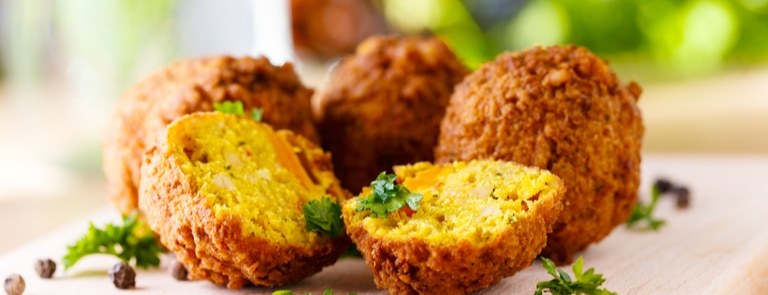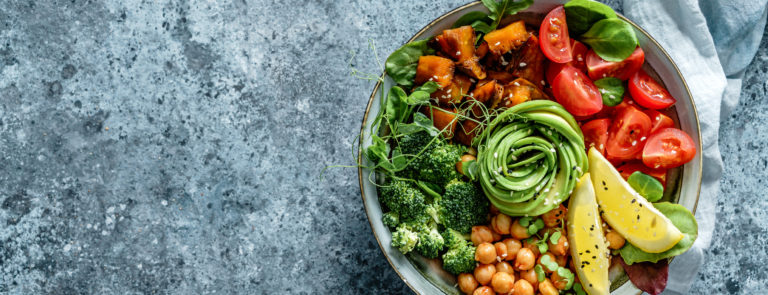15% off €35 OR 20% off €45
5 health benefits of falafel

Those of us that have tried falafel already know it is delicious. But did you know it is also packed with a range of health benefits too?
Falafel is a deep-fried ball or patty that is traditionally made with chickpeas and various spices and herbs.
It is a common street food in Egypt and the Middle East. And because it is made without meat, it has grown to be a staple part of a vegetarian and vegan diet all over the world.
Falafel is also a key part of a healthy Mediterranean diet, which largely consists of legumes, fruits, vegetables, and healthy sources of fats and proteins.
So, just how good is falafel for you? Read on to find out more!
Firstly, what are the main falafel ingredients?
Before delving into the health benefits of falafel, it is good to know what is actually in it.
The main ingredient is chickpeas, which are also known as garbanzo beans. They are a type of legume that are beige and round.1
They also have a creamy, nutty texture and flavour.
When it comes to chickpea nutrition, chickpeas are a good source of protein and fibre and contain several vitamins and minerals.2
Falafel is also made with herbs and spices, including cumin, coriander and paprika.
Fans of spicy food sometimes like to add chopped chillies to give their falafel a bit of a kick.
Finally, falafel is commonly served with hummus. This plant-based dip is made by blending chickpeas, tahini, olive oil, lemon juice, and garlic.3
Hummus has a nutty taste and texture that complements the flavour of falafel perfectly.
Nutritional value of falafel
An average 17g homemade falafel patty contains4:
| Energy | Carbs | Fat | Protein | Sodium | Calcium | Iron | Potassium | Vitamin B6 | |
|---|---|---|---|---|---|---|---|---|---|
| Amount | 57 kcal | 5.4g | 3g | 2.26g | 50mg | 9.18mg | 0.58mg | 99mg | 0.021mg |
| % of RDA* | 2.9% | 2% | 4% | 5% | 2% | 1% | 3% | 2% | 2% |
The 5 best falafel health benefits
Is falafel healthy? Here we'll dive into falafel's top 5 health benefits.
-
Falafel is a good source of plant-based protein
It can sometimes be a challenge for vegetarians and vegans to get sufficient protein into their diet without meat.
Every day, most adults need approximately 0.75g of protein for each kilo of their body weight. This works out to be 45g for women and 55g for men.5
Thankfully, chickpeas are an excellent source of protein.
Protein helps to build muscle and makes hormones and enzymes.6 It is also a source of energy and is an essential part of a healthy diet when eaten in moderation.
-
Falafel may help you feel full for longer
As we have already determined, falafel contains both protein and fibre. Both work in conjunction with one another to help keep you feeling full throughout the day.
This is because fibre contains acetate, which is an anti-appetite molecule.7
When fibre is consumed, acetate gets released into the bloodstream, colon and brain, sending chemical reactions to our brain to tell it we are full.8
Studies also suggest that fibre is an important regulator of ghrelin levels.9
Ghrelin is known as the ‘hunger hormone.’ The stomach releases it to stimulate appetite, promote the storage of fat, and increase food intake.10
Fibre has been shown to help reduce the production of hunger hormones, preventing those pesky hunger pains that often lead to over-eating.
-
Falafel may help to manage blood sugar levels
High-carb foods, such as pizza and chips, raise blood sugar levels quickly, leading to energy slumps.11
Whereas falafel is a complex carbohydrate, which contains fibre, vitamins and minerals that take longer to digest.
Fibre slows down sugar absorption, which helps to control blood sugar levels.12
Soluble fibre – the kind that is in falafel – can also reduce levels of bad cholesterol.13
-
Falafel can help improve support normal bowel function
A lack of fibre in the diet can cause constipation, which affects around 20% of people each year.14,15
The dietary fibre in falafel cannot be digested, but it helps to make stools bigger and softer.
This allows them to pass through the gut more quickly and easily. It can also help discourage painful straining.
-
Falafel can help you lose weight as part of a calorie controlled diet
Falafel is low in calories and fat. When eaten as part of a healthy diet, it can aid with weight loss or weight maintenance.
One of the healthiest ways to eat falafel is in a buddha bowl with plenty of healthy greens and veggies.
When making your falafel, be careful not to use too much oil, as this adds unnecessary fat and calories.
Last updated: 9 April 2021
- https://www.medicalnewstoday.com/articles/280244
- https://www.medicalnewstoday.com/articles/280244
- https://www.healthline.com/nutrition/is-hummus-healthy
- https://www.nutritionvalue.org/Falafel%2C_home-prepared_nutritional_value.html
- https://www.bhf.org.uk/informationsupport/heart-matters-magazine/nutrition/protein
- https://www.betterhealth.vic.gov.au/health/healthyliving/protein
- https://time.com/84888/the-food-the-mysteriously-makes-you-feel-full-explained/
- https://time.com/84888/the-food-the-mysteriously-makes-you-feel-full-explained/
- https://pubmed.ncbi.nlm.nih.gov/19369431/
- https://www.yourhormones.info/hormones/ghrelin
- https://www.hsph.harvard.edu/nutritionsource/carbohydrates/carbohydrates-and-blood-sugar/
- https://www.mayoclinic.org/healthy-lifestyle/nutrition-and-healthy-eating/in-depth/fiber/art-20043983
- https://www.diabetes.co.uk/nutrition/soluble-fibre.html
- https://www.webmd.com/food-recipes/features/4-warning-signs-your-diet-may-lack-fiber
- https://www.healthline.com/nutrition/fiber-and-constipation-truth



